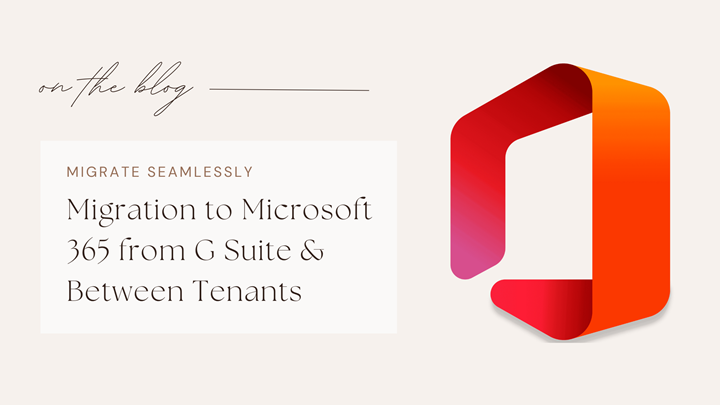When it comes to cloud productivity platforms, Google Workspace also known as G Suite and Microsoft 365 also known as Office 365 stand out as top platforms. Both offer comprehensive suites designed to streamline workflows, boost collaboration, and enhance productivity. From emails and shared documents to cloud storage and video conferencing, these platforms cover it all. Despite these similarities, many businesses eventually consider switching to Microsoft 365. Why? Microsoft 365’s seamless integration with its applications, robust security features, and flexible pricing plans often make it a compelling choice.
In this guide, we’ll explore two common migration scenarios and how to navigate them smoothly:
- Migrating from G Suite to Office 365
- Tenant-to-Tenant Migration within Microsoft 365
Migrating from Google Workspace to Office 365
Switching from Google Workspace to Office 365 might seem overwhelming, but with the right approach, it can be straightforward and efficient.
Key Steps for performing the migration:
- Pre-Migration Assessment: Start by taking a close look at your current Google Workspace setup. Identify what needs to be migrated—emails, contacts, calendars, and Drive files. A detailed plan can help streamline the process.
- Setting Up Office 365: Next, prepare your new Microsoft 365 environment. Create user accounts, assign licenses, and configure security settings. It will save the time while performing migration.
- Data Migration: Use Microsoft’s native migration tools or trusted third-party solutions to transfer your data. These tools simplify moving emails, files, and calendars with minimal disruption. Native tool works almost perfectly but requires time and efforts. For detailed information on the native process, you can read this article on migrate from G Suite to Office 365.
- Post-Migration Tasks: Once the data has been moved, double-check everything. Ensure all files and emails are intact, update DNS records to reroute emails to Office 365, and offer training sessions to help your team adapt to the new platform.
Best Practices:
- Clearly communicate the migration plan to all users and higher management to avoid confusion.
- Schedule the migration during off-peak hours to minimize disruptions.
- Run pilot migrations with a small user group before scaling up to the entire organization.
Tenant to Tenant Migration within Microsoft 365
Tenant to Tenant migration often occur during business mergers, acquisitions, or organizational restructuring. While these migrations can be complex, careful planning makes a world of difference.
Key Steps:
- Pre-Migration Planning: Begin by assessing both the source and destination tenants. Map user accounts, review licensing needs, and plan for any necessary coexistence between environments during the migration.
- Data Migration: Migrate mailboxes, SharePoint sites, Teams data, and OneDrive content using Microsoft’s built-in tools or reliable third-party software. Data integrity is crucial here, so ensure thorough checks throughout the process.
- Post-Migration Validation: After the migration, verify that all data has been successfully transferred. Test user access, review configurations, and address any issues that arise.
Note: Native tool only supports mailbox and OneDrive migration. It also requires cross-tenant user data migration license for performing the same.
Best Practices:
- Keep communication lines open between IT teams and end-users to ensure everyone is on the same page.
- Use a phased migration approach for large organizations to minimize risks.
- Conduct post-migration security and compliance checks to safeguard your data.
Conclusion
Migrating to Microsoft 365—whether from Google Workspace or between tenants—doesn’t have to be complicated. With careful planning, clear communication, and the right tools, you can make the process smooth and efficient. Following best practices ensures data integrity, minimizes downtime, and helps your organization take full advantage of everything Microsoft 365 has to offer.
It is always better to go with the third-party solutions if you do not have required knowledge or want to move the large user data.
Read more: Convert EML to PST Files

